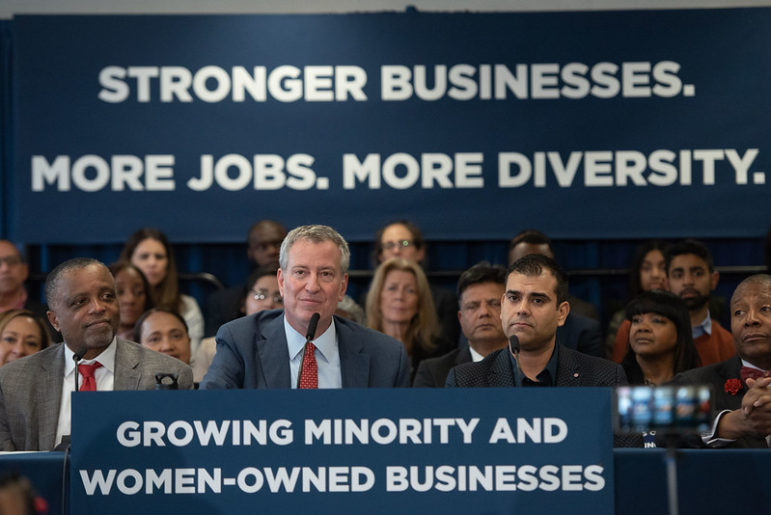‘We made the change by changing our culture—and how we worked—to intentionally identify, mentor, network, promote and hire individuals that improved our outcomes and enhanced the organization’s diversity.‘

Michael Appleton/Mayoral Photography Office
City officials at a press conference about workplace diversity in 2019.We often hear managers report they interviewed a Black candidate, but “they weren’t qualified.” When it comes to hiring, Black Americans and other underrepresented groups face discrimination at every step of the employment process.
We also hear that the pool of underrepresented candidates ready for executive leadership is shallow and the pipeline narrow. We agree. But the problem isn’t with the candidates: people of color are often systematically excluded from leadership opportunities, despite one survey which found 52 percent of people of color indicated a strong desire for top leadership roles, according to a recent report released by the Building Movement Project, an organization based in New York City.
A 2018 NYC Services and NPCC report found that 70 percent of the city’s nonprofit CEOs and executive directors are Caucasian and only 15 percent are Black, despite Blacks making up 24 percent of the population.
According to the Building Movement Project report, institutional support—or the lack of it—is responsible for the gap between the desire of people of color to lead and realization of that goal. The report found that whites get mentored more often. Mentoring is key to advancement. “In 2016, 43 percent of respondents of color said they had a mentor within their organization, compared with half of whites. By 2019, the percentage of respondents of color saying so had risen to 48 percent—but an even larger percentage of whites—56 percent—said they had received internal mentoring.”
The fact is, little has changed in over a decade. In 2009, Philanthropy New York released a groundbreaking study, “Benchmarking Diversity, A First Look at New York City Foundations and Nonprofits,” which found that 70 percent of nonprofit executive staff were Caucasian. It’s clearly time we do more to invest in people of color and move the dial on organizational leadership diversity.
 CityViews are readers’ opinions, not those of City Limits. Add your voice today!
CityViews are readers’ opinions, not those of City Limits. Add your voice today!
There are multiple paths to executive leadership, the easiest being family legacy and influence and, typically for the rest of us, broad experience and being networked. It worked for us. But it happened because we were chosen, we were introduced, and we were mentored.
That does not happen for enough Black Americans and other people of color. Native-born Black individuals especially are denied, discouraged and persistently excluded from success. Yes, the pool is shallow and the pipeline is narrow—that is in many ways intentional.
It doesn’t have to be that way.
At The Children’s Village, one of the nation’s oldest children and family serving organizations, we had an executive team that was mostly white in 2004, and the pipeline among our 450 employees was not diverse. We decided to change. Diversity on our executive team has doubled from 30 to 60 percent. More than half of our administrative team—our bench—is now made up of people of color. And last year, 80 percent of internal promotions were people of color. For an organization that now counts over 1450 employees, this is a significant shift, driven by a commitment to diversity, equity and inclusion.
We made the change by changing our culture—and how we worked—to intentionally identify, mentor, network, promote and hire individuals that improved our outcomes and enhanced the organization’s diversity.
We started by insisting that our executive leaders identified and hired candidates of color and we held them accountable for doing so. Diversity and inclusion is a regular agenda item, not just at our management team meetings, but at our board meetings too—elevating the conversation and the visibility to the top. Additionally, we regularly monitor our diversity dashboard to measure against progress. Those charts and numbers reinforce the organization’s commitment to improving diversity.
We also required executives to mentor and invest in relationships. Mentorship is critical. When successful it creates opportunities for learning, personal growth and introduction to a broader network. We asked staff to set aside time every week to identify, mentor, and network hard-working staff that go unnoticed. And the CEO led by example, not just mentoring new people, but continuing to mentor long-standing mentees, some who were elevated to the executive team.
Our organization stipulated that first and foremost internal diverse candidates must be considered for open positions and tasked hiring managers and the Human Resources department to identify individuals for promotions. Last year, out of 140 internal promotions and transfers, 75 were Black/African American and a total of 117 were people of color.
And we also fostered internal awareness and dialog around issues of race and “otherness.” Individuals—internal or external—with lived experience were invited to speak with the larger organization. It’s different hearing directly about navigating in a different skin than reading about it in the paper.
Finally, but importantly, we recognized that color is not a proxy for true diversity. New immigrants of color contribute greatly and enrich our democracy, but they are not a substitute for native-born Black Americans. The American narrative continues to be anti-Black, where some immigrants of color are chosen and presented as an example of diversity. If you have people of color among your executives and in your pipeline but no native-born Blacks, your work remains undone.
All this work took tremendous effort. And the work is not done—nor will it ever be. Creating a diverse workforce is to make a commitment to work differently, permanently. It is worth all the effort. Diversity is not about numbers. It is about creating successful organizations, communities and society.
Jeremy Kohomban, Ph.D. is president and CEO of The Children’s Village and president of Harlem Dowling. Alastair Short is a board member at The Children’s Village. Deborah Finley-Troup, MS, is vice president of Human Resources at The Children’s Village.








